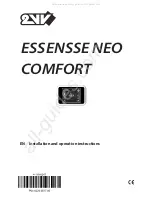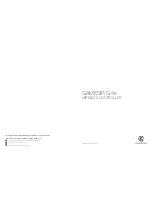
6 720 820 872 (2016/12)
CR 400 | CW 400 | CW 800
36 | Service menu
The heating curve is the decisive basic factor for an economic
and convenient operation of the heating system with weather-
compensated control. To calculate the curve, the control
system requires you to enter a number of parameters for the
heating system, from which it automatically calculates the
optimum heating curve by means of a mathematical formula.
This calculation takes into account the adjusted outside
temperature and the room control temperature. The room
control temperature is an internal operand based on the
desired room temperature (set room temperature) and the
room influence factor.
This allows the end customer to influence the heating curve
directly by modifying the set room temperature.
The most important settings are the design temperature,
maximum flow temperature, room temperature offset (parallel
displacement) and minimum outside temperature.
The heating curve (
Æ
Fig. 21 and 22) is mainly determined by
the base point and end point. The base point is located at 25 °C
flow temperature at a room temperature of 21 °C with an
adjusted outside temperature of 20 °C. The end point of the
heating curve must be set according to the design temperature
of the heating system.
The course of the heating curve (inclination/steepness) is
determined by the parameters
minimum outside
temperature
(
Æ
page 30) and
design temperature
(the flow
temperature at minimum outside temperature)
(
Æ
Fig. 21 and 22. left).
The heating curve can be shifted up or down parallel to the
original curve by adjusting the room temperature offset and/or
the set room temperature (
Æ
Fig. 21 and 22, right).
Max. flow
temperature
30 ...
75
... 85 °C
(radiator/convector)
30 ...
48
... 60 °C
(underfloor heating
system)
Maximum flow temperature
Solar influence
– 5 ... – 1 K
Within certain limits, the solar irradiation influences the weather-compensated
control (the additional heat from the sun lowers the required heat output).
Off
The solar irradiation is not considered by the control.
Room influence
Off
The weather-compensated control operates independently of the room
temperature.
1 ...
3
... 10 K
Deviations in the room temperature to the extent set are set off by parallel
displacement of the heating curve (only available if the user interface is installed in
a suitable reference room). The higher the setting value, the greater the weighting
of the room temperature deviation and the maximum possible influence of the
room temperature on the heating curve.
Room
temperature
offset
– 10 ...
0
... 10 K
Parallel displacement of the heating curve (e.g. when the room temperature
measured with a thermometer deviates from the set value)
Fast heat-up
Off
No excessive increase in the flow temperature and the end of a setback phase
0 ... 100 %
The quick heat-up accelerates the heating-up after a setback phase. The higher the
setting value, the greater the excess flow temperature and the end of a setback
phase. The set building type affects the duration of the excess (
Æ
Type of building,
page 30). This setting is only available if the room influence is switched off.
Menu item
Adjustment range
Description
Table 16 Set heating curve menu
The heating curve that is graphically
represented in the display refers to a range
from + 20 °C to the minimum outside
temperature set under
System data
.
Summary of Contents for CR 400
Page 63: ...6 720 820 872 2016 12 CR 400 CW 400 CW 800 63 Notes ...
Page 64: ......















































